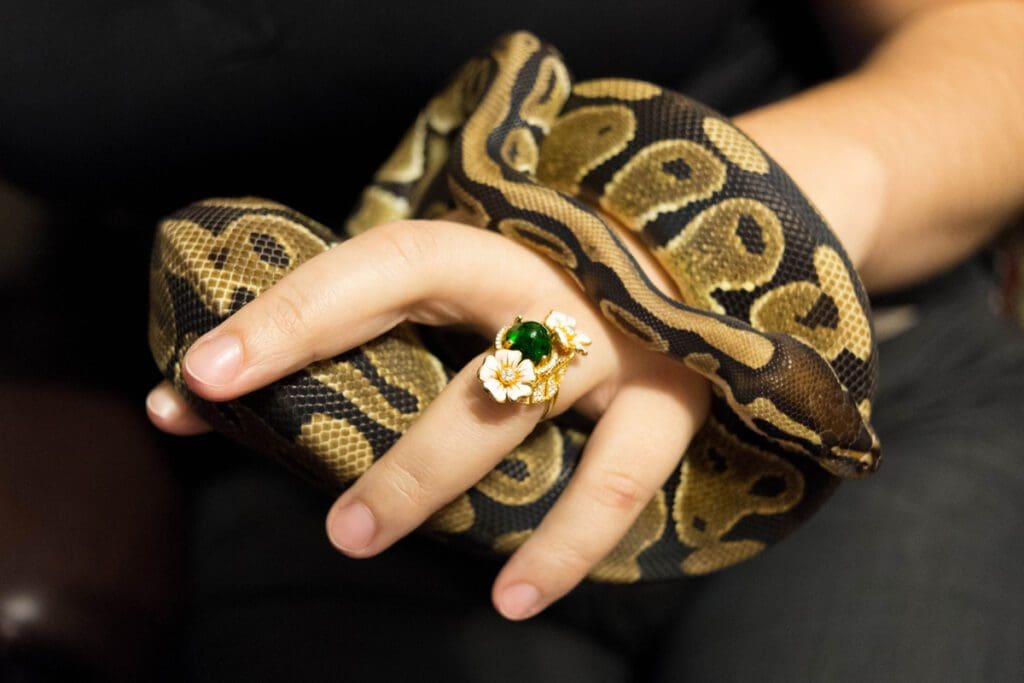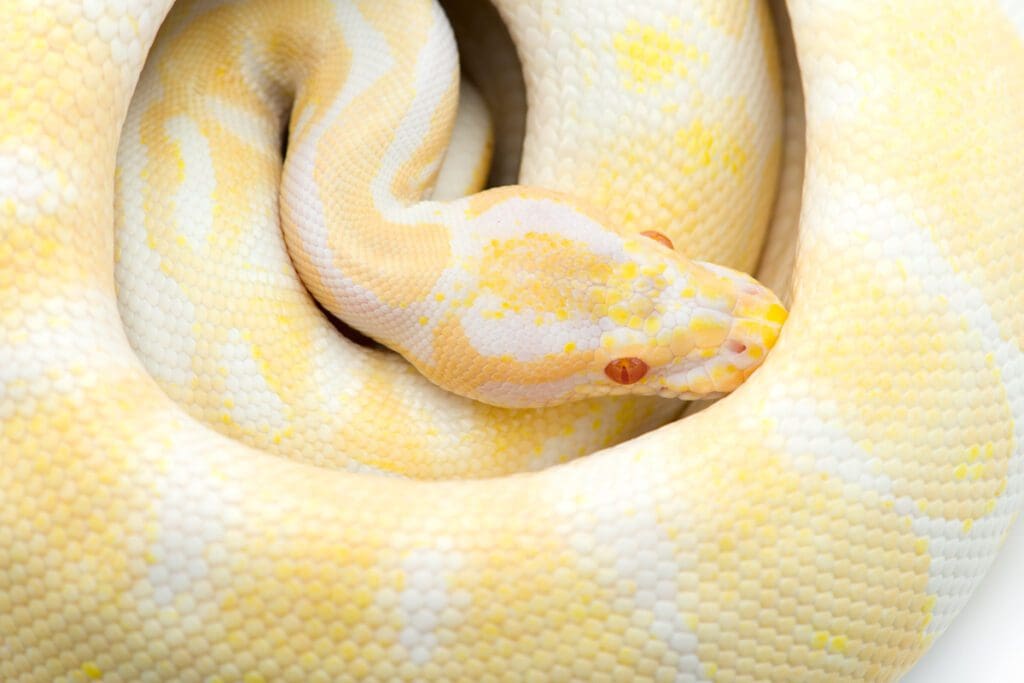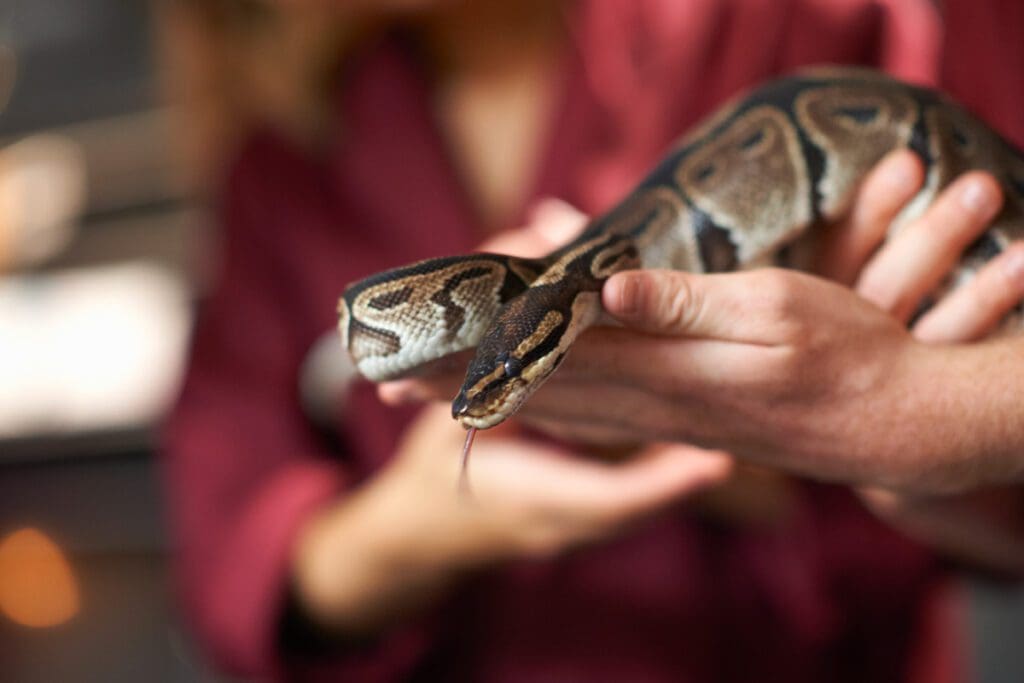For aspiring snake enthusiasts and first-time reptile keepers, the world of pet snakes can seem like a daunting place. However, ball pythons (Python regius) are a gentle, low-maintenance variety.
Be aware, that choosing a ball python as a pet is a long-term commitment. With proper care, they have a lifespan of 20-30 years, and some may potentially live even decades longer.
In this article, we’ll explore why ball pythons make fantastic beginner snakes, covering topics such as how to choose one, their behavior, housing, feeding, and common health concerns.
How to Choose a Ball Python

Selecting the right ball python is a crucial first step. You’ll want to look for the following characteristics when deciding which ball python to choose:
1. Captive-Bred: Always choose a captive-bred ball python from a reputable breeder or pet store. Although these may be more expensive, there are several reasons it is the better choice. Captive-bred snakes are generally healthier, less stressed, and more accustomed to captivity.
Wild-caught snakes tend to be stressed from capture and transport, as well, and often have parasites.
2. Alert and Active: When choosing a ball python, opt for one that is alert and responsive. It should move without any signs of illness or injury. Check for clear eyes and healthy skin.
3. Good Appetite: Look for a ball python with a healthy appetite, as it is a positive sign of a healthy snake. Inquire about its feeding history to ensure it has been eating regularly.
4. Temperament: While ball pythons are known for their docile nature, individual personalities can vary. Choose one that exhibits calm behavior and doesn’t show signs of aggression or excessive shyness.
Ball Python Behavior
Ball pythons are renowned for their placid temperament, making them ideal for beginners. Here are some key aspects of their behavior to be aware of:
1. Curling into a Ball: When stressed or scared, ball pythons often curl into a tight ball, with their head hidden in the center of their coil. Hence, the name “ball python.”
2. Nocturnal: Ball pythons are primarily nocturnal, meaning they are most active during the night. They tend to be less active during the day and may spend much of their time in hideouts.
3. Handling: Regular, gentle handling from an early age helps a ball python become more accustomed to human interaction. This is essential for reducing stress and building trust.
How to House a Ball Python

Proper housing is crucial for the health and well-being of your new snake. Young ball pythons grow for three years at a rate of about one foot per year.
Youngsters can live comfortably in a 20-gallon tank but will need a 30-gallon tank after three years when they reach adulthood.
1. Enclosure: Be aware that these guys are escape artists. A secure, escape-proof enclosure is a must. A glass or plastic terrarium with a secure lid or a reptile-specific enclosure works well.
2. Substrate: Use a suitable substrate, such as newsprint, Astroturf, or shredded bark such as aspen shavings or cypress mulch, to create a comfortable and humidity-friendly environment.
3. Temperature and Humidity: Maintain a temperature gradient in the enclosure, with a warm side (85-90°F) and a cool side (75-80°F). Maintain humidity at 50-60% for most of the enclosure, but provide a humidity hideout with higher levels (80-90%) to aid shedding.
4. Hideouts & branches: These snakes require secure hideouts on both the warm and cool sides of the enclosure to reduce stress and promote proper thermoregulation.
In addition, they also like sturdy branches in their enclosures as well.
Feeding a Ball Python
Feeding ball pythons is relatively straightforward:
1. Prey Size: Choose prey items that are appropriate for the snake’s size. Young ball pythons eat small rodents, while adults consume larger ones.
2. Feeding Schedule: Offer food once every 5-7 days for young snakes and every 10-14 days for adults. Adjust the schedule as needed based on your snake’s appetite and metabolism.
3. Prey Type: These snakes can be exclusively fed mice or small to medium-sized rats. Fuzzy mice for young snakes, and larger prey for adult snakes (depending on size).
Use frozen-thawed prey items whenever possible. Using live prey risks injury to the snake. Frozen prey also reduces the chance of disease transmission.
4. Feeding technique: To help with the taming and handling process, it is a good idea to move the snake out of its cage into a separate enclosure for feeding.
This will help the snake associate feeding with the other enclosure, while also helping it not confuse your hand for prey when you put it into the cage.
Ball Python Health Problems

While ball pythons are hardy reptiles, they can still encounter health issues:
1. Respiratory Infections: Respiratory infections can occur if the enclosure’s humidity and temperature are not properly maintained. Signs include wheezing, bubbling from the mouth, and nasal discharge.
2. Mites: External parasites called mites can infest ball pythons. Check for small, black specks around the snake’s eyes and vent.
3. Shedding Problems: Inadequate humidity can lead to shedding difficulties. A healthy snake should shed its skin in one piece. Retained shed on toes or tail tips can lead to circulation issues.
4. Regurgitation: Overhandling, stress, or inappropriate feeding can cause regurgitation. This is when the snake vomits its meal.
5. Low/no appetite: Sometimes they refuse to eat (even captive-bred) and will fast for a couple of months. As long as the snake maintains its condition and body weight, fasting is not necessarily a problem.
Make sure stress isn’t the problem by taking a close look at how your snake is being cared for, itself, and its environment. If the fast becomes prolonged, or the snake loses over 10% of its weight, consult a veterinarian or another experienced snake keeper for advice.
Final Thoughts
Ball Pythons are excellent choices for novice reptile keepers due to their gentle nature, low-maintenance requirements, and manageable size.
By choosing a healthy specimen of ball python, and providing proper housing, feeding, and monitoring for potential health concerns, you can enjoy the rewarding experience of caring for these fascinating snakes.






